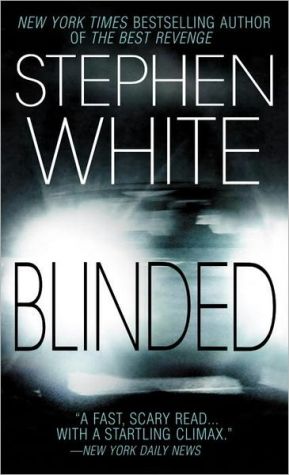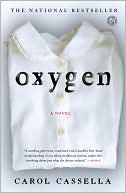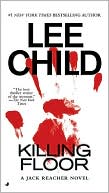Blinded
Relentlessly probing the very edge of the human psyche as only he can, psychologist and New York Times bestselling author Stephen White ratchets up the thrills in BLINDED, a novel of psychological suspense – his most compelling and powerful yet.\ Gibbs Storey is a woman no man can resist. When her comfortable life is shattered by the man she thought it was safe to give her heart to, the nightmare has only just begun. Psychologist Alan Gregory is used to dealing with nightmares. But a brutal,...
Search in google:
In his latest masterwork of psychological suspense, the New York Times bestselling author of The Program, Warning Signs, and The Best Revenge peers into a troubled marriage to craft a shattering tale of secrecy, eroticism, betrayal, and murder. Psychologist Alan Gregory is juggling his responsibilities as a father, a husband, and doctor when a beautiful woman walks into his office with an astounding admission. Gibbs Storey believes that her husband may have murdered a woman. Then, Gibbs stuns Alan again with another revelation: She thinks there are other victims…and her husband is not finished killing yet.Publishers WeeklyMurder, sex and guilt are all on the couch in bestseller White's latest (Cold Case; Manner of Death; etc.) featuring ongoing series hero Alan Gregory, a low-key sleuth/psychologist. As always, the author delivers an absorbing mystery, a mix of interesting subplots involving Gregory's sympathetic friends and family, and a paean to the beauty of the Colorado countryside. This time he splits the point of view equally between Gregory and Gregory's best friend, Boulder police detective Sam Purdey. Sam has just had a heart attack and is facing a dreaded rehabilitation regimen when his wife decides to leave him, perhaps permanently. Gregory has his own plateful of domestic difficulties caring for his MS-stricken wife and his toddler daughter while tending to a full caseload of clients who run the gamut from mildly neurotic to full-blown psychotic. An old patient he hasn't seen in a year, the beautiful Gibbs Storey, comes back for therapy and announces that her husband has murdered a former lover, and she's not sure what to do about it. And by the way, she thinks he may have murdered a bunch of other women as well. Gregory decides that, as a therapist, he cannot report the murders to the police, spending pages and pages justifying his decision. He turns to recuperating pal Sam, and the two of them separately follow various threads until all is resolved, just in the nick of time. White is known for his surprise endings, and this one is no exception. Aside from the repetitive and less than convincing ethical considerations, it's an engrossing addition to an excellent series. (Feb. 3) Copyright 2003 Reed Business Information.
Chapter One\ Alan\ Nine-fifteen on Monday morning. My second patient of the day.\ Gibbs Storey hadn’t changed much in the ten years since I’d last seen her. If anything, she appeared to be even more of a model of physical perfection than she’d been in the mid-nineties. I guessed yoga, maybe Pilates. Her impeccable complexion hadn’t suddenly become pocked with acne or ravaged by psoriasis, nor had her high cheekbones dropped to mortal levels. Her blond hair was shorter but no less radiant, and her eyes were the same sky blue I remembered. The absence of any wrinkles radiating around them caused me to wonder about a recent Botox poke, but I quickly surmised that Gibbs’s fair skin would probably never be susceptible to the tracks of age. She’d be in possession of some magic gene, and she’d be immune.\ She’d always had beauty karma. Along with popularity karma. And the ever-elusive charm karma.\ She didn’t have marriage karma, though.\ I’d first met Gibbs and her husband, Sterling, when they came to see my clinical psychology partner, Diane Estevez, and me for therapy for their troubled relationship. Diane and I saw them conjointly—a quaint, almost anachronistic therapeutic modality that involved pairing a couple of patients with a couple of therapists in the same room at the same time—for only three sessions. Ironically, with therapy fees being what they are and managed care being what it is, Diane and I hadn’t done a conjoint case together since that final session with Gibbs and Sterling Storey.\ After they’d abruptly canceled their fourth session and departed Boulder—“Dr. Gregory, Sterling got that job he wanted in L.A.! Isn’t that wonderful!” Gibbs informed me breathlessly in the voicemail she’d left along with her profound thanks for how helpful we’d been—neither Diane nor I had heard a word from either of them. That was true, at least, until Gibbs called, said she was back in town, and asked me for an individual appointment.\ Gibbs’s call requesting the individual appointment had come ten days before, on a Friday. My few free slots the following week didn’t meet any of her needs, so we’d settled on the Monday morning time. At the time she had accepted the week-and-a-half delay graciously.\ In the interim between her call and her first appointment, I’d pulled her thin file from a box in the storage area that was stuffed with the records of old, inactive cases and examined my sparse notes. The few lines of intake and progress reports that I’d scrawled after the conjoint sessions told me less than did my memory, but I didn’t need copious notes to remind me that Diane and I hadn’t been all that helpful to Gibbs and Sterling.\ Couples therapy is not individual therapy with two people. It is a whole different animal, more closely akin to group therapy with a radioactive dyad. Issues within couples aren’t subjected to the simple arithmetic of doubling; problems seem to be susceptible to the more severe forces of logarithmic multiplication. Therapeutic resistance in couples work, especially conjoint couples work, isn’t just the familiar dance between therapist and patient. Instead, a well-choreographed rou- tine between husband and wife takes place alongside every interaction between either client and either therapist. Each marital partner knows his or her steps like an experienced member of a ballroom dancing pair. She retreats as he aggresses. He surely demurs as she swoons.\ A couples therapist needs to learn everyone’s moves before he or she can be maximally effective.\ My memory of the Storeys’ conjoint treatment was that Diane and I had only just begun to recognize their peculiar tango when they terminated the therapy and moved to California.\ The first conjoint session had been a typical “what brings you in for help” introductory. “Communication” was the buzzword of the day in the care and feeding of relationships, and that’s the culprit the Storeys identified as the reason they had entered into our care. Each maintained that they desired assistance “communicating” more effectively with the other. He was, perhaps, a little less certain than she of his motivation.\ Neither Diane nor I had believed either of them. No, we didn’t entertain the possibility that they were out-and-out lying to us—at least I didn’t; I could never be a hundred percent certain about Diane—but rather we were waiting for them to approach the revelation that they might be lying to themselves, or to each other, about their reason for being in our offices. “Communication problems” was a socially acceptable entree to treatment—an acceptable thing to tell their friends.\ But Diane and I weren’t at all convinced at the time that it was the reason we were seeing the Storeys.\ “Hi, Dr. Gregory,” Gibbs said as she settled on the chair in my office for her first individual appointment. Her greeting wasn’t coy exactly, but it wasn’t not-coy exactly either. “Long time,” she added.\ Her fine hair was pulled back into a petite ponytail. She smiled in a way that almost dared me not to notice how together she looked.\ I nodded noncommittally. My practiced chin dip could have been measured in millimeters.\ “I’m sure you’re wondering why I’m here,” she said.\ Another microscopic nod on my part. Most days while doing my work as a psychologist, if I were paid by the word I’d go home a pauper. But Gibbs was right, I was wondering why she’d come back to see me after so many years. I had a guess—I was wagering that she’d divorced Sterling and had moved back to Boulder to start a new life. It was a scary journey for most people. Me? I was going to be the tour guide.\ That was my guess.\ “You remember Sterling? My husband?”\ Husband? Okay, I was wrong. The Storeys were separated then, not divorced.\ I spoke, but since it was Monday morning I failed to assemble a complete sentence. “Yes, of course” was all I said.\ Gibbs raised her fingertips to her lips and leaned forward as though she were whispering a profanity and was afraid her grandmother would overhear. She said, “I think he murdered a friend of ours in Laguna Beach.”\ Okay, I was wrong twice.
\ Publishers WeeklyMurder, sex and guilt are all on the couch in bestseller White's latest (Cold Case; Manner of Death; etc.) featuring ongoing series hero Alan Gregory, a low-key sleuth/psychologist. As always, the author delivers an absorbing mystery, a mix of interesting subplots involving Gregory's sympathetic friends and family, and a paean to the beauty of the Colorado countryside. This time he splits the point of view equally between Gregory and Gregory's best friend, Boulder police detective Sam Purdey. Sam has just had a heart attack and is facing a dreaded rehabilitation regimen when his wife decides to leave him, perhaps permanently. Gregory has his own plateful of domestic difficulties caring for his MS-stricken wife and his toddler daughter while tending to a full caseload of clients who run the gamut from mildly neurotic to full-blown psychotic. An old patient he hasn't seen in a year, the beautiful Gibbs Storey, comes back for therapy and announces that her husband has murdered a former lover, and she's not sure what to do about it. And by the way, she thinks he may have murdered a bunch of other women as well. Gregory decides that, as a therapist, he cannot report the murders to the police, spending pages and pages justifying his decision. He turns to recuperating pal Sam, and the two of them separately follow various threads until all is resolved, just in the nick of time. White is known for his surprise endings, and this one is no exception. Aside from the repetitive and less than convincing ethical considerations, it's an engrossing addition to an excellent series. (Feb. 3) Copyright 2003 Reed Business Information.\ \ \ \ \ Library JournalWhite's 12th mystery brings back Alan Gregory, a psychoanalyst in Boulder, CO. When a beautiful client tells him she suspects her husband of murder, he begins to investigate, only to be told that four more women have been killed and more corpses may turn up. Doctor-client confidentiality-a common theme in White's works-means that Gregory cannot tell his cop friend, Sam, anything, leaving only hints and instinct to guide him. The narrative alternates between the voice of Gregory, erudite, introspective, and thoughtful, and that of Sam, streetwise, practical, and self-deprecating. Using his own real-life experiences as a psychologist to portray clients and cases with sympathy and realism, White skillfully blends sexual tension, domestic strife, moments of humor, a variety of striking characters, and a tautly constructed plot. The book's literary allusions will delight readers; current fans will rejoice, and newcomers will certainly want to check out White's earlier works (e.g., Warning Signs). Highly recommended. [Previewed in Prepub Alert, LJ 10/1/03.]-Roland Person, formerly with Southern Illinois Univ. Lib., Carbondale Copyright 2003 Reed Business Information.\ \ \ Kirkus ReviewsNow that his patients, his friends, and his wife have all been suspected of murder, what's left for Boulder psychologist Alan Gregory (The Best Revenge, Feb. 2003, etc.)? An ex-patient whose wife wants to spill all confidentially without turning him in. Television producer Sterling Storey and his stunning wife Gibbs always enjoyed an adventurous sex life-so adventurous that Gibbs's brief mention of it years ago drove Sterling out of therapy and out to LA. But if Gibbs can be believed now that she's back on her own, Sterling's hunger for excitement wasn't limited to the occasional taboo-busting rendezvous with a stranger; he may well have strangled his Laguna Beach neighbor Louise Lake, a British flight attendant, six years ago. Even worse, Gibbs eventually confides in Alan, Louise may not have been Sterling's only victim, and he may be planning even more return engagements to his one-time flings. As Alan agonizes over what to do with this privileged information, his hand is forced when several confidences his other patients have vouchsafed-news that a District Court judge's husband is selling drugs, the identity of a mystery businesswoman who shut down Denver International Airport when she impatiently breached a security checkpoint to catch her plane-somehow leak from his office. Will Gibbs's secret be next? If so, Alan can't expect much help from his wife Lauren, whose MS has been suddenly exacerbated, or from his detective friend Sam Purdy, who's taken off for Georgia to check out an accident site from which Sterling disappeared, presumed dead by everybody but Sam and Alan and rangy Laguna Beach cop Carmen Reynoso. The stage is set for a breathtaking Thanksgiving climax. In order to setup the blood and thunder, though, White, who never stints on complications, has to crosscut among so many threats, subplots, and red herrings that you may forget to be thrilled. Agent: Lynn Nesbit/Janklow & Nesbit\ \








